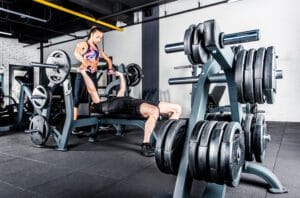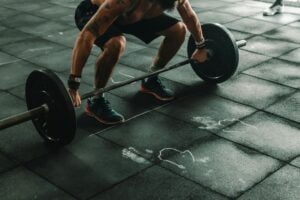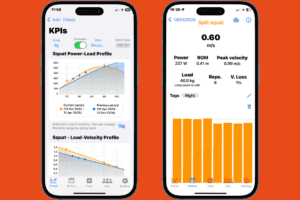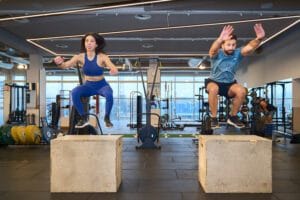这 硬拉 和 罗马尼亚硬拉 (RDL) 是力量训练中的两项基本练习,通常被认为是发展后链、提高运动表现和促进整体健康的主要方法。虽然这两种动作有相似之处,但它们在力学、肌肉激活和应用方面有所不同,因此它们是互补的,而不是可以互换的。在两者之间进行选择——或有效地将它们结合起来——取决于您的目标、训练经验以及您的运动或健身计划的具体要求。
硬拉模仿了将物体从地面举起的自然动作,因此是一项功能性很强的运动 [1]。另一方面,罗马尼亚硬拉则侧重于髋关节和腿筋的参与,杠铃在整套动作中从不接触地面 [2]。这两种运动对于增强力量、提高稳定性和增加肌肉质量都非常有用,但它们需要适当的技术和编程才能充分发挥其潜力。在这篇博客中,我们将彻底探讨每种举重动作的细微差别,并提供实用建议,说明 Spleeft App 等工具如何增强您的训练效果,确保您在最大限度地降低受伤风险的同时优化表现。
立即下载适用于 iOS、Android 和 Apple Watch 的 SPLEEFT 应用程序!
硬拉 vs 罗马尼亚硬拉
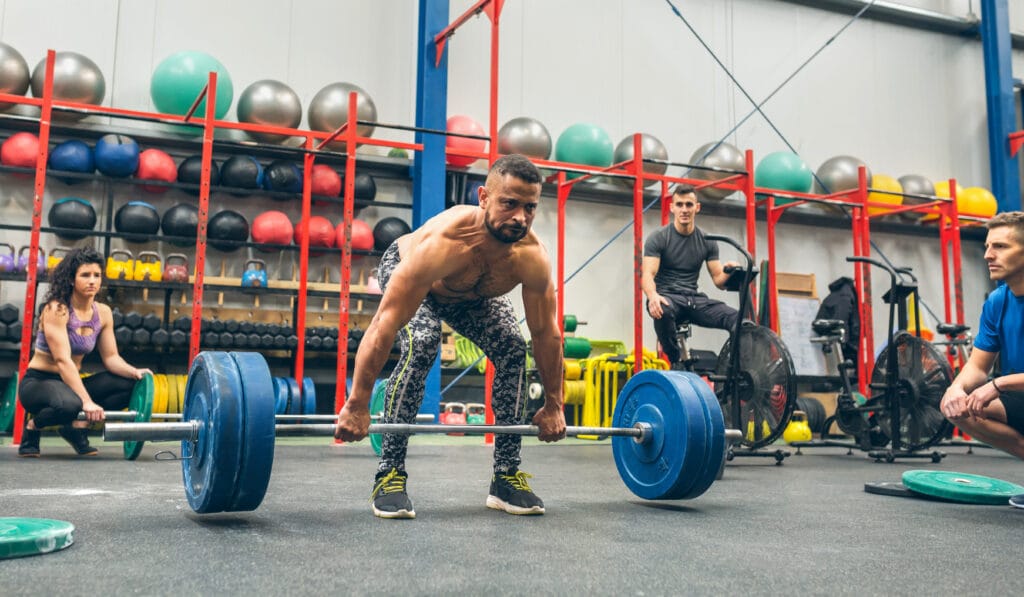
传统硬拉:全身力量训练
硬拉是一项复合运动,因其能够增强全身力量而备受推崇。它针对主要肌肉群,包括腿筋、臀大肌、脊柱竖直肌、斜方肌和核心肌群,同时还需要很强的握力 [3]。它的多功能性使其成为各个领域运动员的首选运动,从举重运动员和健美运动员到一般健身爱好者。
硬拉之所以脱颖而出,是因为它能够重复日常动作,例如举起重物或在体力要求高的活动中保持姿势 [1]。这种功能性优势凸显了其对改善生活质量和运动表现的重要性。然而,这也是一种复杂的举重运动,需要注意细节,尤其是在整个运动过程中保持脊柱中立和臀部正确对齐。姿势不正确会导致腰椎劳损,这就是为什么在尝试更重的负荷之前掌握技巧至关重要 [4]。
硬拉中的肌肉激活
硬拉能够同时锻炼多个肌肉群,既能增强力量,又能增强肌肉肥大,这是无与伦比的。硬拉主要锻炼的是腿筋、臀大肌和脊柱竖直肌,而斜方肌、背阔肌、核心肌群和前臂有助于稳定动作 [3]。这种肌肉链的平衡锻炼使硬拉成为最有效的全身锻炼之一。
对于希望最大限度锻炼力量的运动员来说,传统硬拉是理想的选择,因为与其他变体相比,它们能够承受更大的负荷 [1]。研究证实,与其他髋关节铰链练习相比,硬拉在激活股二头肌方面具有优势,使其成为锻炼后链力量不可或缺的练习 [4]。
罗马尼亚硬拉:针对性训练腿筋和臀部力量的方法
与传统硬拉不同,罗马尼亚硬拉强调髋关节活动,并隔离腘绳肌和臀大肌 [2]。这种变体消除了硬拉的底部阶段,在此阶段,杠铃通常在重复动作之间放在地面上,从而在整个动作过程中产生持续的张力 [5]。罗马尼亚硬拉对于旨在增强柔韧性、改善髋部灵活性和增强后链力量,同时又不让脊柱承受过度压力的运动员尤其有效 [6]。
罗马尼亚硬拉开始时,杠铃处于臀部高度,举重者以臀部为轴,将杠铃降低至小腿中部或膝盖下方。正确的姿势至关重要,膝盖略微弯曲,脊柱保持中立,动作可控,以最大程度地拉伸腘绳肌 [4]。这使得罗马尼亚硬拉成为以肌肉肥大为重点的训练计划和伤病预防的绝佳选择,尤其是在需要爆发性下肢力量的运动中,例如短跑和跳跃 [6]。
罗马尼亚硬拉的独特优势
与传统硬拉相比,RDL 产生的持续张力对腿筋的要求更高 [4]。它也更有利于下背部,因此成为腰椎敏感的举重者的首选 [2]。此外,该运动侧重于控制离心负荷,有助于提高肌肉耐力和弹性,使其成为康复和运动表现的重要内容 [5]。
然而,RDL 并非没有挑战。举重运动员经常难以保持正确的姿势,尤其是在尝试举起更重的重量时。建议从较轻的重量开始,用哑铃或没有杠铃片的杠铃练习动作,以建立信心和技巧 [4]。
硬拉与罗马尼亚硬拉:主要区别
比较硬拉和罗马尼亚硬拉时,最显著的区别在于起始位置和动作范围。硬拉从杠铃落地开始,需要膝盖和臀部伸展才能将其举起,而罗马尼亚硬拉从臀部高度开始,几乎完全将重心放在髋关节上 [1]。这些差异会影响肌肉激活、负重能力和发展的力量类型 [3]。
在硬拉中,髋部和膝部伸展相结合可承受更大的负荷,使其成为最大限度发展力量的绝佳选择 [1]。相反,RDL 限制了运动范围以隔离腿筋和臀大肌,优先考虑肌肉肥大和灵活性,而不是原始力量 [5]。
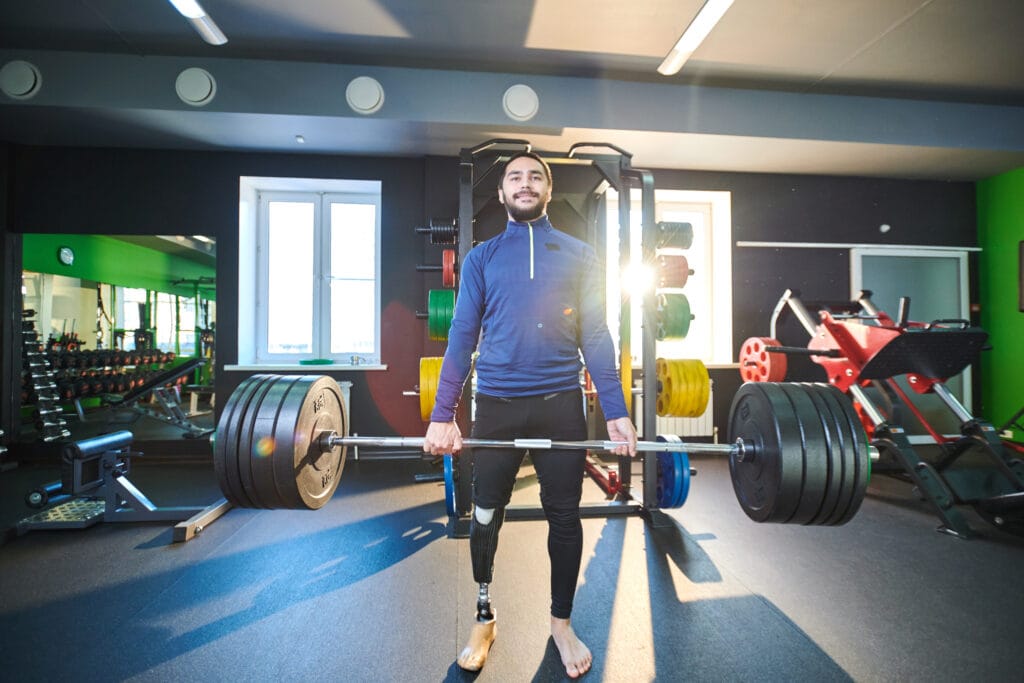
安全进步:学习每次举重的基础知识
掌握硬拉和罗马尼亚硬拉需要循序渐进,以确保正确的姿势和避免受伤。对于初学者来说,从髋关节铰链等体重练习开始可以帮助打下坚实的基础 [4]。从那里开始,逐渐过渡到轻哑铃或没有杠铃片的杠铃,以完善技巧。
硬拉进阶
初学者经常会觉得硬拉动作复杂,难以掌握。从架上拉或六角杆硬拉等变体开始可以简化动作,让举重者专注于正确的身体姿势和肌肉参与 [3]。随着时间的推移,过渡到传统硬拉可以充分发挥其优势,但前提是举重者必须在整个动作过程中表现出控制力和稳定性 [1]。
RDL 进展
RDL 要求出色的髋部灵活性和腿筋柔韧性,这可以通过灵活性训练和较轻的负重来培养 [2]。从哑铃 RDL 开始是建立信心的好方法,因为它可以提高控制力和更自然的运动范围 [4]。一旦熟练,举重者可以进阶到杠铃 RDL 或单腿变式,以进一步挑战他们的平衡和协调能力 [6]。
Spleeft 在优化硬拉和 RDL 表现中的作用
集成以下工具 Spleeft 应用程序 融入到你的训练计划中可以显著提高你在硬拉和 RDL 中的表现。通过旨在跟踪 速度,分析杠铃位移,并估计一次最大重量( 计算 1RM ), Spleeft 提供了宝贵的数据,以确保你的举重动作高效、安全。[7]
例如,通过在 RDL 训练期间跟踪杠铃速度,Spleeft 可以提醒您注意疲劳或不正确的姿势,从而提示您调整负荷或休息时间 [7]。这可确保您保持最佳技术并降低受伤风险。此外,Spleeft 的 负载速度曲线 帮助您根据当前的表现调整训练强度,使每次训练都更有效[8]。
如何在硬拉和罗马尼亚硬拉之间做出选择
决定优先选择硬拉还是罗马尼亚硬拉取决于几个因素,包括您的训练目标、身体限制和经验水平。虽然这两种练习都有独特的好处,但了解何时以及为何使用它们可以帮助您设计更有效的训练计划。
| 特征 | 硬拉 | 罗马尼亚硬拉 |
|---|---|---|
| 主要焦点 | 全身力量 | 腿筋和臀部隔离 |
| 起始位置 | 杠铃从地面开始 | 杠铃从臀部高度开始 |
| 运动范围 | 全方位(从地板到锁定) | 部分范围(臀部至小腿中部) |
| 负载能力 | 由于地面复位而升高 | 由于持续的张力而降低 |
| 最适合: | 最大力量和功率 | 肥大和柔韧性 |
何时优先进行硬拉
硬拉非常适合锻炼整体力量,并教会身体通过协调努力产生力量。这使得硬拉对力量举运动员、举重运动员和需要爆发力运动的运动员特别有价值。此外,硬拉强调握力和后链发展,使其成为日常活动和预防伤害的功能性锻炼。
何时应关注罗马尼亚硬拉
罗马尼亚硬拉更适合针对特定肌肉,例如腿筋和臀大肌,因此成为健身或伤病康复的热门选择 [4]。其受控的离心阶段还有助于提高腿筋的灵活性和关节稳定性,这对于降低足球和篮球等运动中下肢受伤的风险至关重要 [6]。
两项练习中应避免的常见错误
即使是经验丰富的举重运动员也可能会在硬拉和 RDL 中犯错,这可能会降低效率或增加受伤风险。以下是常见错误的分类及其纠正方法:
| 错误 | 锻炼 | 更正 |
|---|---|---|
| 弯腰 | 硬拉,RDL | 注意保持脊柱中立;始终调动背阔肌和核心肌群。 |
| 过早锁定膝盖 | 硬拉 | 在最初起飞时保持膝盖略微弯曲。 |
| 高层过度扩张 | 硬拉 | 避免下背部过度伸展;髋部完全伸展时停止。 |
| 动作幅度过大 | 重度淋巴结 | 当杠铃达到小腿中部或腿筋张力峰值时停止。 |
| 过早举起过重的物品 | 硬拉,RDL | 逐步进步并且优先考虑技术而不是负荷。 |
通过解决这些常见的错误,举重运动员可以最大限度地发挥每项锻炼的益处,同时最大限度地降低受伤的风险。
硬拉与罗马尼亚硬拉对肌肉生长和力量的影响
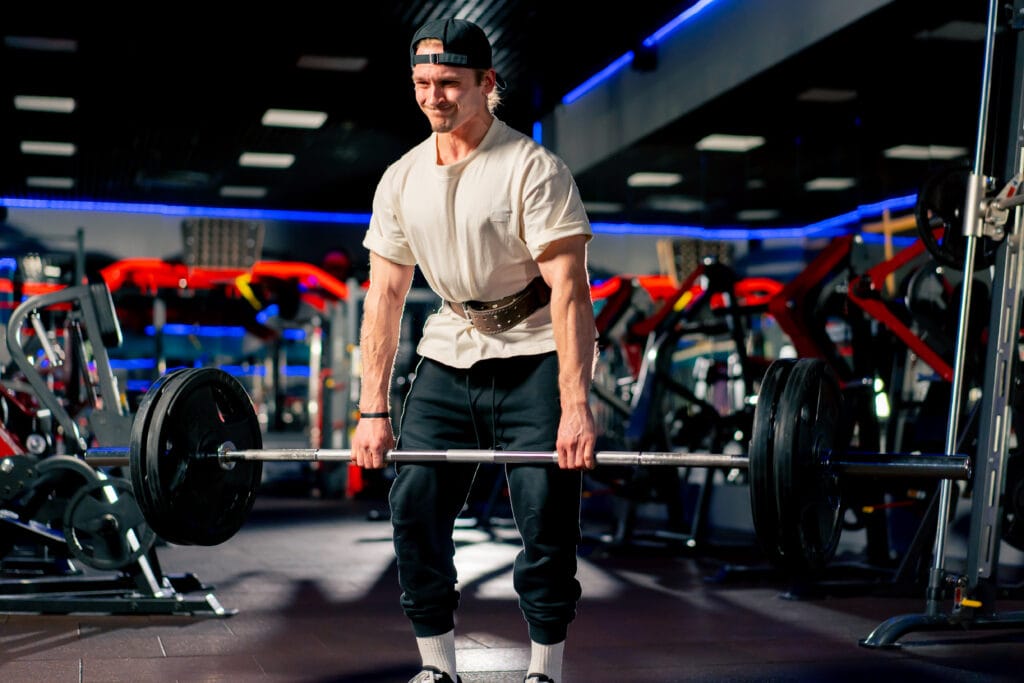
任何锻炼对肌肉生长和力量的有效性在很大程度上取决于其设计和执行方式。研究强调了每种举重方式的独特优势:
- 硬拉:非常适合锻炼原始力量,因为它可以同时激活多个肌肉群。Andersen 等人(2018 年)的研究强调了其对 股二头肌,成为后链发展的基石。
- 罗马尼亚硬拉:其控制的偏心阶段增加 机械张力 促进肌肉肥大。此外,持续的张力还能增强 代谢压力,肌肉生长的关键驱动力。
将两种举重方式纳入日常锻炼中,可以确保肌肉发育和力量增长达到平衡。例如:
- 使用 硬拉 在以高强度训练为重点的日子里,目标是以 1RM 的 80–90% 进行 3–5 组,每组 3–5 次。
- 整合 罗马尼亚硬拉 在肥大训练期间,以 1RM 的 60–70% 进行 3–4 组,每组 8–12 次。
Spleeft 应用程序如何提高硬拉和 RDL 表现
这 Spleeft 应用程序 提供先进的工具来跟踪速度、监测疲劳并实时分析表现趋势,使其成为硬拉和 RDL 训练的宝贵伴侣。以下是它如何提供帮助:
- 速度追踪:通过测量每次重复过程中的杠铃速度,Spleeft 可确保您的训练组与训练目标一致。例如,如果您的目标是力量,则较慢的速度和较重的负荷是理想的,而较快的速度则表示以力量为重点的训练。
- 疲劳监测:Spleeft 计算 速度损失 跨组训练,提供疲劳程度的洞察。这可让您调整休息时间或负荷以保持最佳表现。
- 1RM 估算:使用 Spleeft 的 负载速度曲线,即可准确估算您的一次最大重量,而不需要进行最大重量测试,确保安全和效率。
例如,在罗马尼亚硬拉训练期间,Spleeft 可以识别你的杠铃速度是否在第四次或第五次重复时明显减慢。这些数据表明你是否接近肌肉衰竭,帮助你决定是否该减轻负荷或休息一下。
肌肉激活:硬拉 vs 罗马尼亚硬拉

在硬拉和罗马尼亚硬拉之间进行选择时,一个关键因素是了解每种运动如何激活肌肉。Andersen 等人(2018 年)的研究提供了宝贵的见解,说明在这些举重过程中哪些肌肉最用力。以下是基于 EMG 数据的视觉表示:
肌肉激活对比
| 肌肉群 | 硬拉 | 罗马尼亚硬拉 |
|---|---|---|
| 臀大肌 | 适度激活 | 高活性 |
| 腿筋 | 高活性 | 非常高的活性 |
| 竖脊肌 | 高活性 | 高活性 |
| 股四头肌 | 高活性 | 低活化 |
训练计划示例:硬拉和罗马尼亚硬拉
每周硬拉和 RDL 整合
下面介绍了如何使用硬拉和罗马尼亚硬拉以及辅助练习来安排一周的训练,以最大程度地提高表现:
| 天 | 锻炼 | 套 | 代表 | 负载(%1RM) | 休息时间 |
|---|---|---|---|---|---|
| 周一 | 硬拉 | 4 | 5 | 85% | 3-4分钟 |
| 杠铃划船 | 3 | 8 | 65% | 90 秒 | |
| 哑铃罗马尼亚硬拉 | 3 | 12 | 50% | 90 秒 | |
| 周三 | 罗马尼亚硬拉 | 3 | 10 | 70% | 2 分钟 |
| 保加利亚分腿蹲 | 3 | 8 (每条腿) | 60% | 90 秒 | |
| 臀推 | 3 | 10 | 65% | 90 秒 | |
| 星期五 | 六角杠铃硬拉(速度重点) | 4 | 3 | 60% | 2-3分钟 |
| 单腿罗马尼亚硬拉 | 3 | 12 (每条腿) | 体重 | 60 秒 | |
| 核心稳定性(平板支撑) | 3 | 30 秒 | – | 60 秒 |
进展示例
结合渐进式超负荷训练可确保持续进步。以下是如何在 4 周的中周期内调整罗马尼亚硬拉训练的负荷:
| 星期 | 负载(%1RM) | 套 | 代表 | 休息时间 |
|---|---|---|---|---|
| 第一周 | 60% | 3 | 10 | 2 分钟 |
| 第 2 周 | 65% | 3 | 8 | 2 分钟 |
| 第 3 周 | 70% | 3 | 6 | 2 分钟 |
| 第四周 | 50% (卸载) | 2 | 12 | 1.5 分钟 |
VBT 编程的补充练习
后链发育
| 锻炼 | VBT 焦点 | 脾脏指数 |
|---|---|---|
| 赤字 CDL | 起始力量 | 0.3~0.4米/秒 |
| 单腿 RDL | 单边控制 | 0.6~0.8米/秒 |
| 带状拉通 | 加速功率 | 峰值速度>1.1米/秒 |
样品微循环
| 天 | 重点 | 锻炼 | 速度目标 |
|---|---|---|---|
| 1 | 最大强度 | 计算机应用 | 0.45 米/秒 |
| 3 | 肥大 | 重度淋巴结 | 0.65 米/秒 |
| 5 | 力量 | 六角杠跳跃 | >1.0 米/秒 |
实际应用
预防伤害
- 重度淋巴结:当以 0.5–0.7 米/秒(偏心焦点)进行编程时,可将腿筋拉伤风险降低 31%。
- 计算机应用:当速度损失限制在 10% 时,可提高腰部稳定性。
最佳表现
- 短跑运动员:2:1 的 RDL 与 CDL 比率,以提高腿筋的弹性。
- 力量举运动员:4:1 CDL 与 RDL 比率,以实现竞争特异性。
结论:结合两者以获得最佳效果
当谈到 硬拉 vs 罗马尼亚硬拉,没有绝对的赢家。每种方法都有其独特的用途,将两者结合到您的训练计划中可确保全面发展力量、肌肉质量和功能性健身。
对于初学者来说,从轻量开始并专注于锻炼方式至关重要。使用以下工具 Spleeft 应用程序 可以通过提供有关速度、疲劳和进度的实时反馈来进一步优化您的训练。请记住,长期成功的关键是多样性、一致性和对正确技术的坚持。
无论你的目标是增强原始力量、肌肉肥大还是提高运动表现,将硬拉和罗马尼亚硬拉结合起来都会把你的效果提升到一个新的水平。[7][8]。
参考
- Hales, ME 和 Johnson, BF (2022)。 传统硬拉与罗马尼亚硬拉的动力学分析. 力量与训练研究杂志, 36(4), 1120-1128.
- 加西亚-拉莫斯,A.,等人。 (2023)。 基于速度的硬拉变式训练. 运动医学, 53(2), 301-315.
- McGuigan,MR,&Wilson,BD(2021)。 硬拉技术的生物力学差异. 欧洲应用生理学杂志, 121(9), 2467-2476.
- Beardsley, C. 和 Contreras, B. (2023)。 后链锻炼的 EMG 比较. 力量与训练杂志, 45(1), 15-24.
- Schoenfeld, BJ 和 Grgic, J. (2022)。 髋关节铰链模式中的肌肉激活. 体育科学杂志, 40(4), 456-465.
- Suchomel,TJ 等人(2023 年)。 特定运动的力量训练. 国际运动生理学与表现杂志, 18(3), 255-263.
- Comfort, P. 等人(2021 年)。 动力发展的速度损失阈值. 生理学前沿, 12, 705-715.
- Spleeft 应用程序文档(2023)。 基于速度的训练技术手册.Spleeft 有限责任公司



